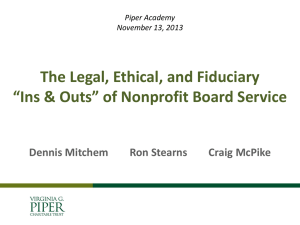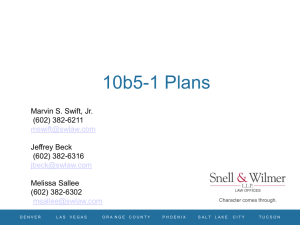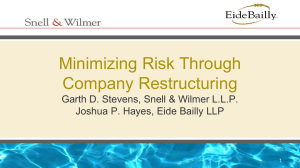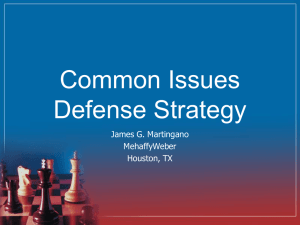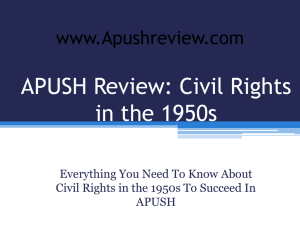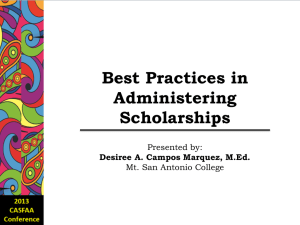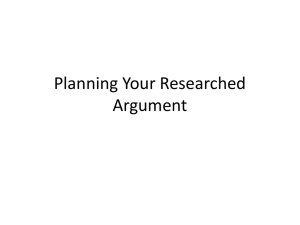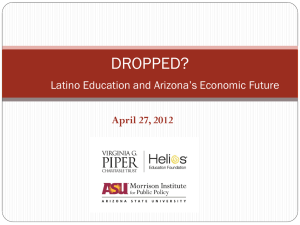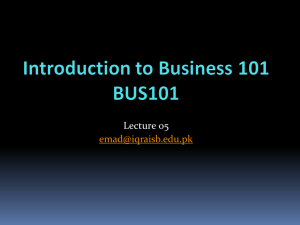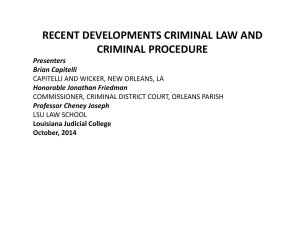Economic Loss Rule - Western Regional Gas Conference
advertisement
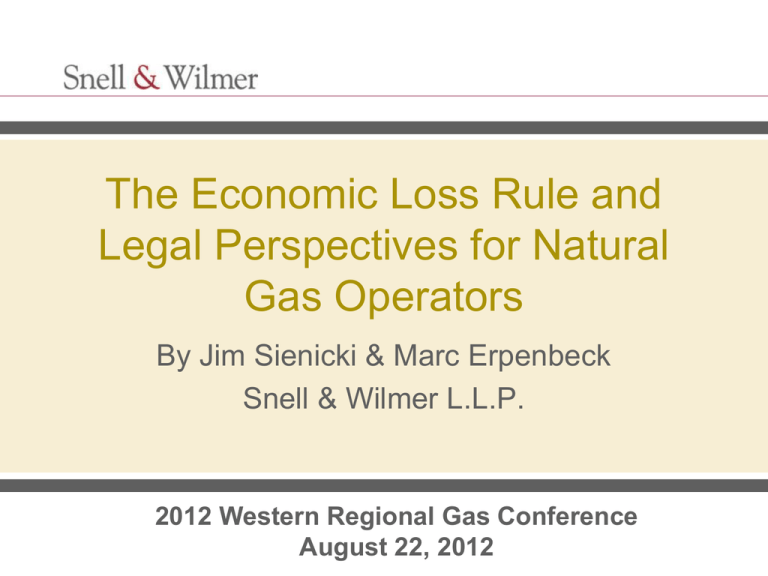
The Economic Loss Rule and Legal Perspectives for Natural Gas Operators By Jim Sienicki & Marc Erpenbeck Snell & Wilmer L.L.P. 2012 Western Regional Gas Conference August 22, 2012 What Is the Economic Loss Rule? • The Economic Loss Rule is easy to state, but can be very difficult to apply. • In certain circumstances, a contracting party is limited to contract remedies for the recovery of damages unaccompanied by physical injury to a person or other property. • In other words: If there is a contract, the injured party is limited to the rights and remedies specified in a contract for purely economic losses ©2012 Snell & Wilmer L.L.P. 2 Economic Loss Rule • Why Does This Matter to You? - Do your contractual terms matter? - Are your rights & obligations limited by contract? - What damages are available? ©2012 Snell & Wilmer L.L.P. 3 Economic Loss Rule cont’d • The Economic Loss Rule is a matter of state law that varies state to state, and is not applied consistently. - Some jurisdictions will not apply the Rule if: • It is not a products liability case • The claim is against a licensed professional who solely provides services (e.g., architect, engineer, construction manager, accountant, lawyer) ©2012 Snell & Wilmer L.L.P. 4 Economic Loss Rule cont’d - Some jurisdictions will not apply the Rule if: • The damage was sudden or calamitous (e.g., gas explosion) • There was a high degree of risk to the public • Negligent misrepresentations • Intentional or egregious torts • Parties involved were not in a direct contract ©2012 Snell & Wilmer L.L.P. 5 The Purpose of the Economic Loss Rule 1. To assure that contract law does not “drown in a sea of tort.” - i.e., to prevent a party from side stepping an unfavorable contract 2. Encouraging parties to negotiate a contract and establish ground rules for their relationship. ©2012 Snell & Wilmer L.L.P. 6 Example of State Variations: Economic Loss Rule for Design Professionals? Arizona California Colorado Nevada New Mexico Utah Yes, if the Plaintiff and Defendant have a contract. Perhaps. Courts are approaching the issue as a fact-specific inquiry. Conflicting case law at the intermediate appeals court. Yes if the parties are in privity; no if there is no privity and a tort duty of care exists independently of contract. It may not be extended to noncommercial transactions. Yes if parties are in privity and claims arise out of that contract; no, if claim is being asserted by homeowner against contractor. No if claim is professional malpractice asserted by client in contractual privity; unclear as to non-clients using an independent duty test. Maybe. Several earlier cases suggest yes although subsequent case law is not clear. ©2012 Snell & Wilmer L.L.P. 7 Contract Law vs. Tort Law: Goals • Contract Law: - • Goal of Contract Law: Encourage parties to mutually define their roles, allocate risks, and identify available remedies Tort Law: - Goal of Tort Law: Compensate an injured party for injuries resulting from another person’s conduct ©2012 Snell & Wilmer L.L.P. 8 Contract Law vs. Tort Law: Claims & Damages • Contract Law: - - Typical Claim: Breach of Contract or Warranties Damages Available: • • • • “Benefit of the Bargain” Damages (Expectation Damages) Put parties in the position they would have been in if the contract was fully performed as agreed upon Reliance Damages Restitution Damages ©2012 Snell & Wilmer L.L.P. 9 Contract Law vs. Tort Law: Claims & Damages cont’d • Tort Law: - - Typical Claim: Negligence, negligence per se, negligent misrepresentation, intentional torts, product liability Damages Available: • • • • • Compensatory Damages Pain and Suffering Emotional Distress Put parties in the position they were in before the injury Punitive Damages ©2012 Snell & Wilmer L.L.P. 10 Contract Law vs. Tort Law • Contract Law: - Parties can prospectively limit the type of damages and amount of damages available to the injured party • - Example: Limitation of liability provisions in the contract; waiver of consequential damage; indemnity provisions; insurance provisions; waiver of subrogation provisions. Insurance may not protect against a party’s breach of a contract claim for a duty that arises out of the contract without a specific contractual liability rider ©2012 Snell & Wilmer L.L.P. 11 Contract Law vs. Tort Law cont’d • Tort Law: - - - - Parties cannot prospectively limit the type of damages and amount of damages available to the injured party Insurance generally protects a negligent party (but usually not intentional torts) Duty usually arises out of the common law or statute Generally has shorter statute of limitations than contract claims ©2012 Snell & Wilmer L.L.P. 12 Arizona Economic Loss Rule – Products Liability • Salt River Project Agricultural Improvement & Power Dist. v. Westinghouse Electric Corp. (1984) • An electric utility company sued the seller of an allegedly defective control device after a turbine exploded and caught on fire. AZ Supreme Court precluded recovery under contract. Did allow a tort claim for strict products liability. (ELR did not apply). • Expressly declined to follow the majority rule for ELR and instead embraced a narrower, case-specific approach. ©2012 Snell & Wilmer L.L.P. 13 SRP v. Westinghouse Electric Corp. (1984) cont’d • Arizona considers three non-dispositive factors (not a bright line test) to determine whether tort or contract law should apply when property has been damaged: • (1) The nature of the defect causing loss, (turns on whether quality or safety concerns are primarily implicated) • (2) How the loss occurred, (whether the loss results from a slow deterioration or a sudden accident or calamity) and • (3) “The type of loss for which the plaintiff seeks redress.” (examines the nature of the loss claimed as well as any other contemporaneous losses) ©2012 Snell & Wilmer L.L.P. 14 Arizona Economic Loss Rule – Products Liability - In the products liability context, Salt River declined to categorically bar tort recovery of economic losses. - Applying a narrow version of the Economic Loss Doctrine, Salt River held that a commercial could assert a products liability claim against a commercial seller for economic losses for which the contract disclaimed liability. ©2012 Snell & Wilmer L.L.P. 15 The Economic Loss Rule – U.S. Supreme Court Decision • East River Steamship Corp. v. Transamerica Deleval, Inc. (United States Supreme Court, 1986): - - Boat charter company charters the boat “as-is” from owner. No remedy against owner. Owner had no claim against turbine manufacturer under its contract. Charter sues the turbine manufacturer (whom it did not have a contract with) for defective design and installation of turbines on 4 different steamships. Sued under negligence for installation and strict products liability for the costs paid to manufacturer for repairs, amounts paid to owner when out of commission, and lost profits (approx. $8 million total). ©2012 Snell & Wilmer L.L.P. 16 The Economic Loss Rule - U.S. Supreme Court Decision cont’d - - - Court declined to follow numerous courts (including Arizona’s) evaluation of potential risks of harm, because they were too uncertain. “Even when the harm to the product itself occurs through an abrupt, accident-like event, the resulting loss due to repair costs, decreased value, and lost profits is essentially the failure of the purchaser to receive the benefit of its bargain -- traditionally the core concern of contract law. . . when a product injures itself, the commercial user stands to lose the value of the product, risks the displeasure of its customers who find that the product does not meet their needs, or, as in this case, experiences increased costs in performing a service. Losses like these can be insured.” Charter was left with no remedy. ©2012 Snell & Wilmer L.L.P. 17 Arizona Economic Loss Rule and the Gas Industry • Valley Forge Insurance Company v. Sam’s Plumbing, LLC (Az. Ct. of Appeals 2009) - Facts: • • • • An explosion at a shopping center in Pinal County, AZ Negligent installation by a plumbing contractor performing gas-line work for one of the center’s tenants allegedly caused the explosion. The explosion damaged not only the gas line and the tenants space, but also significant portions of the shopping center structure. No one was injured. The shopping center’s insurance – Valley Forge - fully compensated the shopping center owner. ©2012 Snell & Wilmer L.L.P. 18 Valley Forge v. Sam’s Plumbing cont’d • Insurance company then sued the plumbing contractor, charging him with negligence and seeking to recover the $1.1 million paid to the center’s owner. • Insurance claimed ELR did not apply because the plumbing contractor’s negligence damaged more than the tenant’s space or the gas lines (the subject of the bargain with the tenant) – it damaged the entire shopping center. • Trial Court held ELR applied – no recovery. ©2012 Snell & Wilmer L.L.P. 19 Valley Force v. Sam’s Plumbing cont’d Appeal: • Trial Court reversed – ELR is not a bar. Held that the same three factor test used in product liability applies to construction defects. • Plumbing contractor had a duty, “separate from any contractually assumed obligation, to exercise reasonable care in any work undertaken. This duty included the specific duty to take precautions to avoid dangerous gas explosions. Insofar as [the plumbing contractor] breached that duty—a factual question that remains to be determined—it is liable for the actual damages that were caused.” ©2012 Snell & Wilmer L.L.P. 20 Arizona Economic Loss Rule – Construction Defects • Flagstaff Affordable Housing Limited Partnership v. Design Alliance, Inc. (2010) - Arizona Supreme Court case Contracting parties cannot pursue tort claims for economic losses (unaccompanied by harm to person or “other property”) unless specified in the contract. ◦ ◦ Does not use Salt River’s Three Factor Test Creates different test for construction defect as opposed to product liability ©2012 Snell & Wilmer L.L.P. 21 Flagstaff Affordable Housing – Miscellaneous Arizona Holdings • Non-Contracting Parties - • Post-Flagstaff Affordable Housing: Applicability of the Economic Loss Rule to claims against noncontracting parties depends on the substantive law at issue Economic Loss Rule could apply even if defendant breached duties imposed by law • - Example - failure to comply with building codes Economic Loss Rule applies to licensed design professionals (but probably not all professionals – like doctors or lawyers – where malpractice claims will continue) ©2012 Snell & Wilmer L.L.P. 22 The Economic Loss Rule in Arizona Today • Two Separate Analyses Now In Arizona: ◦ Product Liability - - ◦ Example: a defective gas line or seal Fact intensive Three Factor test. No privity requirement. Construction Defect - - - Example: faulty installation of a gas line Bright line rule Unreasonably dangerous activity not considered in analysis Privity required ©2012 Snell & Wilmer L.L.P. 23 Arizona Economic Loss Rule and the Gas Industry cont’d • How Would Valley Forge Be Decided Today? - - Different analysis – since Flagstaff and not Salt River would apply. Potential different tactics used by Plaintiff and Defendant • • ◦ - - “Chain of contracts” versus direct privity Damage to non-contracted for property covered by ELR? Is a gas line/tenant space just another part of the building? Probably same result but for entirely different reason. Flagstaff doesn’t look at the unreasonable dangerous analysis in construction defect, but would look to privity. Under Flagstaff, no privity between Contractor and Mall Owner, thus ELR likely does not apply. If it followed the US Supreme Court, there is a “chain of contracts” and ELR applies. ©2012 Snell & Wilmer L.L.P. 24 Contract Drafting Tips • Prime Contractor - - • Subcontractor - • Ensure that the owner does not preserve tort remedies in the contract Carefully draft limitations of liability, waiver of consequential damages, indemnity insurance, and subrogation provisions Ensure that prime contractor’s protections against owner’s tort claims pass through to protect the subcontractor Owner - Preserve tort remedies in the prime contract Ensure that both contract and tort remedies are available against both prime contractor and subcontractors ©2012 Snell & Wilmer L.L.P. 25 Recent U.S. Supreme Court Cases Governing Regulatory Fines and Procedures • Recent United States Supreme Court opinions provide further protections for corporate defendants - Southern Union Company v. United States (United States Supreme Court, 2012) - Sackett v. EPA (United States Supreme Court, 2012) ©2012 Snell & Wilmer L.L.P. 26 Recent Supreme Court Cases Governing Regulatory Fines and Procedures • Southern Union Company v. United States (United States Supreme Court, 2012) ◦ Facts: - - Natural gas distributor found guilty of violating environmental laws for storage of mercury without a permit. ◦ Criminal fines accrue on a daily basis Jury was not asked to specify the duration of the violation. Instead, judge imposed a criminal fine based on his own determination of the duration of the violation. ©2012 Snell & Wilmer L.L.P. 27 Recent Supreme Court Cases Governing Regulatory Fines and Procedures cont’d ◦ Holding: The Sixth Amendment reserves to juries the determination of any fact that increases a criminal defendant’s maximum potential sentence. - Applies to both criminal sentences and criminal fines. $18,000,000 fine became a $50,000 fine. ◦ ◦ ◦ Importance of Case: - Criminal fines tied to the duration of a violation require a jury to decide the defendant violated the law on each particular day. • The court cannot assess a fine absent such jury findings. Thus, it will be more difficult to assess large criminal fines against businesses based on duration of the violation. ©2012 Snell & Wilmer L.L.P. 28 Recent Supreme Court Cases Governing Regulatory Fines and Procedures cont’d • Sackett v. EPA (United States Supreme Court, 2012) ◦ Background: - ◦ Property owners must obtain a permit before adding fill materials to designated “wetlands” Facts: - EPA accused homeowners of illegally filling in “wetlands” on property. EPA issued compliance order to restore “wetlands.” ©2012 Snell & Wilmer L.L.P. 29 Recent Supreme Court Cases Governing Regulatory Fines and Procedures cont’d • Sackett v. EPA (United States Supreme Court, 2012) ◦ Essentially, the homeowners were left with two options: - - 1. Accept EPA’s “wetlands” determination and stop accruing penalties; or 2. Wait until the Enforcement Action was filed to challenge EPA’s “wetlands” determination, while allowing potential penalties of up to $75,000 per day to accrue indefinitely ©2012 Snell & Wilmer L.L.P. 30 Recent Supreme Court Cases Governing Regulatory Fines and Procedures cont’d ◦ Holding: - ◦ Defendants could challenge the Compliance Order immediately Impact: - - In certain circumstances, a party can challenge agency action without having to wait for enforcement proceedings to commence Restricts EPA from using heavy handed Compliance Orders ©2012 Snell & Wilmer L.L.P. 31 Conclusion • Questions or comments? ©2012 Snell & Wilmer L.L.P. 32
